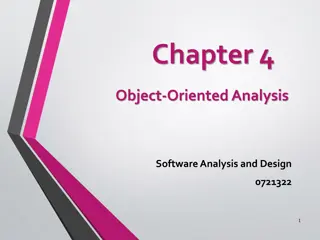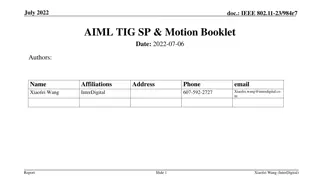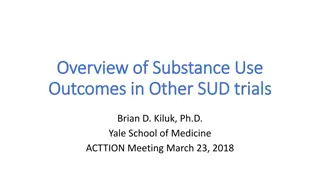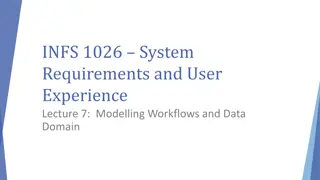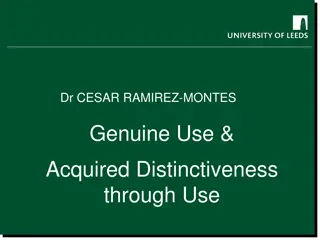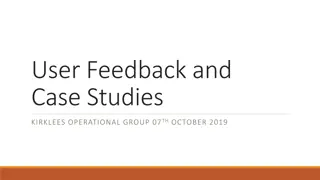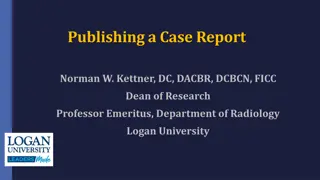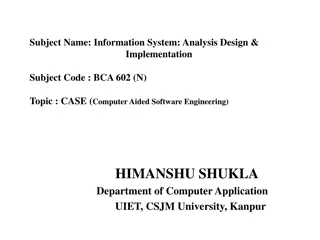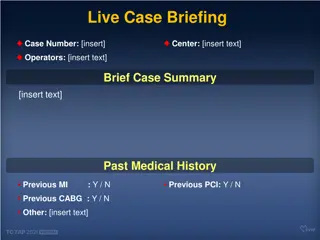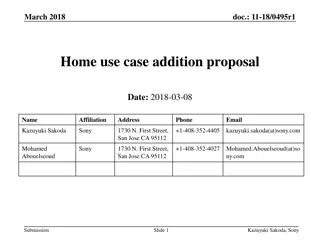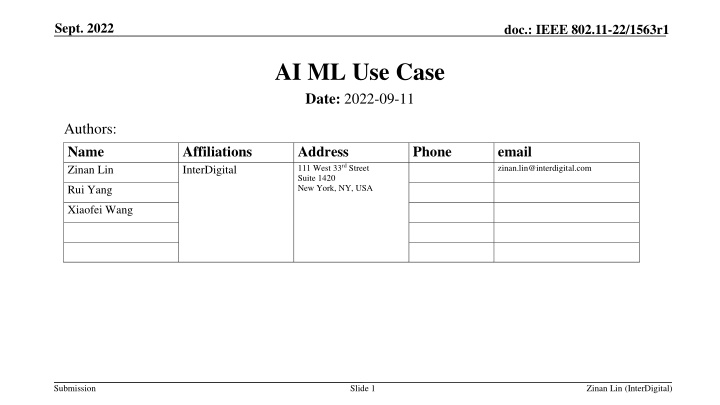
Enhancing WLAN Performance through AI/ML Use Cases
Explore the application of AI/ML in WLAN through a detailed discussion on use cases, including data handling, WLAN performance benefits assessment, and impact on backward compatibility. Discover potential AI/ML solutions for CSI compression to optimize system throughput and reduce feedback overhead.
Download Presentation

Please find below an Image/Link to download the presentation.
The content on the website is provided AS IS for your information and personal use only. It may not be sold, licensed, or shared on other websites without obtaining consent from the author. If you encounter any issues during the download, it is possible that the publisher has removed the file from their server.
You are allowed to download the files provided on this website for personal or commercial use, subject to the condition that they are used lawfully. All files are the property of their respective owners.
The content on the website is provided AS IS for your information and personal use only. It may not be sold, licensed, or shared on other websites without obtaining consent from the author.
E N D
Presentation Transcript
Sept. 2022 doc.: IEEE 802.11-22/1563r1 AI ML Use Case Date: 2022-09-11 Authors: Name Zinan Lin Affiliations InterDigital Address 111 West 33rd Street Suite 1420 New York, NY, USA Phone email zinan.lin@interdigital.com Rui Yang Xiaofei Wang Submission Slide 1 Zinan Lin (InterDigital)
Sept. 2022 doc.: IEEE 802.11-22/1563r1 Abstract In this contribution, we have a follow-up discussion on the application of AI/ML in WLAN [1] and propose one AI/ML use case in WLAN for AIML TIG technical report [2]. Submission Slide 2 Zinan Lin (InterDigital)
Sept. 2022 doc.: IEEE 802.11-22/1563r1 Summary of Questions on [1] Q1: How data can be stored and handled? Use case dependent Belongs to the framework of AI/ML data collection and processing Q2: How to determine if AI/ML benefits the WLAN performance? Belongs to feasibility study Q3: How does AI/ML enhanced feature impact the backward compatibility/coexistence with legacy device? Use case dependent Belongs to feasibility study Q4: What topics belong to the TIG? Use case [2] Framework of AI/ML data collection and processing? Feasibility study [2] Submission Slide 3 Zinan Lin (InterDigital)
Sept. 2022 doc.: IEEE 802.11-22/1563r1 Use Case - CSI Compression Background The AP initiates the sounding sequence by transmitting the NDPA frame followed by a NDP which is used for the generation of V matrix at the STA The STA applies a compression scheme (i.e., Givens rotations) on the V matrix and feeds back the angels in the beamforming report frame Problem statement Supporting MIMO with more transmitter antennas is one way of achieving higher throughput, e.g., in UHR Multi AP (MAP) may be one potential feature in the next 802.11 generation [3-5], e.g. UHR Larger number of transmit antennas and MAP features will lead to significantly increased sounding feedback overhead, which increases the latency and limits the throughput gain Submission Slide 4 Zinan Lin (InterDigital)
Sept. 2022 doc.: IEEE 802.11-22/1563r1 Use Case CSI Compression Potential AI/ML solutions [6, 7] Unsupervised Learning (USL) Example 1: Apply K-mean to classify the reported angel vectors [8] Simulation results show that iFOR uses ~ 8% of the number of bits required by the existing feedback mechanism and boost the system throughput by up to 52% Example 2: Apply Deep Neural Network Autoencoder (DNN-AE) to compress the reported angles (LB- SciFi) [9] Experimental results show that LB-SciFi can reduce the feedback overhead by 73% and increase the network throughput by 69% on average Backward compatibility and coexistence The AI/ML enhanced STA may fall back to the legacy CSI reporting algorithm easily Coexistence may not be a problem foreseen Legacy STAs may benefit from the reduced medium occupation time Submission Slide 5 Zinan Lin (InterDigital)
Sept. 2022 doc.: IEEE 802.11-22/1563r1 CSI Compression Framework of AIML Data Collection and Processing (1/2) Framework Benefits Standard Impact AI/ML applied in AP only, e.g. [8] May reuse the legacy CSI reports as the training data Only AP stores and processes the training data and obtains the training model May not require non-AP STA to have AI/ML capability Migrate from the current standard in a relatively easy manner Minimum changes Require signalings between AP and non-AP STAs (e.g., CSI report format, capability indication, CSI candidate set, etc) AI/ML applied in non-AP STAs only, e.g., [8] Non-AP STAs may train CSI reports independently For example [8], each non-AP STA may individually obtain the CSI candidate set using AI/ML and propose the CSI candidate set to AP AP determines the final CSI candidate set High demand on the non-AP STA capability Require some signaling between AP and non-AP STAs (e.g., CSI report format, capability indication, CSI candidate set etc) Note: Framework may also depend on the specific algorithm used for CSI compression Submission Slide 6 Zinan Lin (InterDigital)
Sept. 2022 doc.: IEEE 802.11-22/1563r1 CSI Compression Framework of AIML Data Collection and Processing (2/2) Framework Benefits Standard Impact AI/ML training applied in AP only and AI/ML algorithm implemented in both AP and non-AP STAs, e.g. [9] May reuse the legacy CSI reports as the training data AP stores and processes the training data and obtain the training model Implement the learning algorithm in AP and non-AP STAs independently Require the same AI/ML model among all STAs The model information may need to be shared from AP to non-AP STAs AI/ML applied in both AP and non-AP STAs May reuse the legacy CSI reports as the training data AP and non-AP STAs store and process the training data and obtain the training model individually Implement the learning algorithm in AP and non-AP STAs independently Require the same AI/ML model among all STAs The model information may need to be agreed and shared between AP and non-AP STAs Note: Framework may also depend on the specific algorithm used for CSI compression Submission Slide 7 Zinan Lin (InterDigital)
Sept. 2022 doc.: IEEE 802.11-22/1563r1 Summary Discuss CSI compression as one potential AI/ML use case for IEEE 802.11 Study the potential AI/ML solutions, backward compatibility/coexistence, and framework of data collection and processing for this use case Submission Slide 8 Zinan Lin (InterDigital)
Sept. 2022 doc.: IEEE 802.11-22/1563r1 References [1] 802.11-22/0950r2, Discussion on Connection between AI/ML & Wireless LAN [2] 802.11-22/0987r0, IEEE 802.11 AIML TIG Technical Report Draft [3] 802.11-22/0729r1, 802.11 GEn8 Study Group [4] 802.11-22/0734r0, Next Gen After 11 be: Main Directions Proposal [5] 802.11-22/0030r1, Look ahead to next generation [6] S. Szott, K. Kosek-Szott, P. Gaw owicz, J. T. G mez, B. Bellalta, A. Zubow, F. Dressler, WiFi Meets ML: A Survey on Improving IEEE 802.11 Performance with Machine Learning , IEEE Communications Surveys & Tutorials [7] 802.11-22/0979r1, Applying ML to 802.11: Current Research and Emerging Use Cases [8] M. Deshmukh, Z. Lin, H. Lou, M. Kamel, R. Yang, I. G ven , Intelligent Feedback Overhead Reduction (iFOR) in Wi-Fi 7 and Beyond, in Proceedings of 2022 VTC-Spring [9] P. K. Sangdeh, H. Pirayesh, A. Mobiny, H. Zeng, LB-SciFi: Online Learning-Based Channel Feedback for MU-MIMO in Wireless LANs, in Proceedings of 2020 IEEE 28th ICNP Submission Slide 9 Zinan Lin (InterDigital)

